2018 KIA K900 service
[x] Cancel search: servicePage 398 of 544
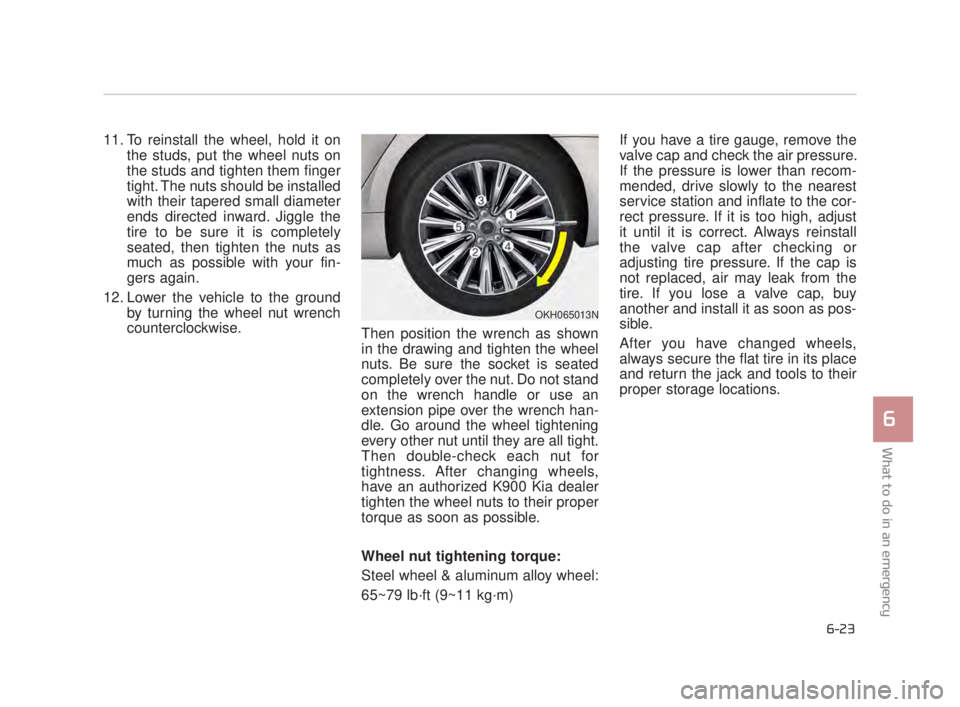
What to do in an emergency
6
6-23
11. To reinstall the wheel, hold it onthe studs, put the wheel nuts on
the studs and tighten them finger
tight. The nuts should be installed
with their tapered small diameter
ends directed inward. Jiggle the
tire to be sure it is completely
seated, then tighten the nuts as
much as possible with your fin-
gers again.
12. Lower the vehicle to the ground by turning the wheel nut wrench
counterclockwise. Then position the wrench as shown
in the drawing and tighten the wheel
nuts. Be sure the socket is seated
completely over the nut. Do not stand
on the wrench handle or use an
extension pipe over the wrench han-
dle. Go around the wheel tightening
every other nut until they are all tight.
Then double-check each nut for
tightness. After changing wheels,
have an authorized K900 Kia dealer
tighten the wheel nuts to their proper
torque as soon as possible.
Wheel nut tightening torque:
Steel wheel & aluminum alloy wheel:
65~79 lb·ft (9~11 kg·m) If you have a tire gauge, remove the
valve cap and check the air pressure.
If the pressure is lower than recom-
mended, drive slowly to the nearest
service station and inflate to the cor-
rect pressure. If it is too high, adjust
it until it is correct. Always reinstall
the valve cap after checking or
adjusting tire pressure. If the cap is
not replaced, air may leak from the
tire. If you lose a valve cap, buy
another and install it as soon as pos-
sible.
After you have changed wheels,
always secure the flat tire in its place
and return the jack and tools to their
proper storage locations.
OKH065013N
KH USA 6:2018 4/12/2017 10:22 AM Page 23
Page 403 of 544

6-28
What to do in an emergency
TOWING
Towing service
If emergency towing is necessary,
we recommend having it done by an
authorized K900 Kia dealer or a
commercial tow-truck service.
Proper lifting and towing procedures
are necessary to prevent damage to
the vehicle. The use of wheel dollies
or flatbed is recommended.It is acceptable to tow the vehicle
with the front wheels on the ground
(without dollies) and the rear wheels
off the ground.
If any of the loaded wheels or sus-
pension components are damaged
or the vehicle is being towed with the
rear wheels on the ground, use a
towing dolly under the rear wheels.
When being towed by a commercial
tow truck and wheel dollies are not
used, the rear of the vehicle should
always be lifted, not the front.
Ensure any metal parts on the tie-
down straps do not contact painted
surfaces or the face of the wheels.
Do not place straps over the body panels or through the wheels.
OKH064014N
A
B
C dolly
OKH065027N
Attaching straps to the chasis,
suspension or other parts of
the body can cause damage.
CAUTION
Side and curtain air bag
If your vehicle is equipped with
side and curtain air bag, set the
ignition switch to LOCK or ACC
position when the vehicle is
being towed. The side and cur-
tain air bag may deploy when
the ignitions is ON, and the
rollover sensor detects the situ-
ation as a rollover.
WARNING
KH USA 6:2018 4/12/2017 10:22 AM Page 28
Page 406 of 544
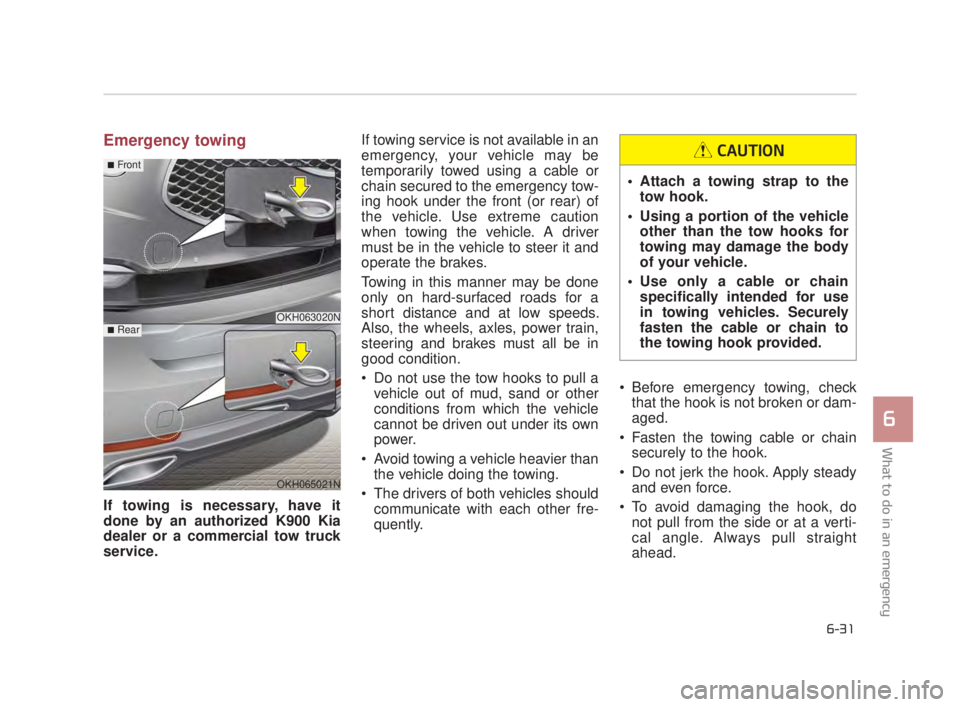
What to do in an emergency
6
6-31
Emergency towing
If towing is necessary, have it
done by an authorized K900 Kia
dealer or a commercial tow truck
service. If towing service is not available in an
emergency, your vehicle may be
temporarily towed using a cable or
chain secured to the emergency tow-
ing hook under the front (or rear) of
the vehicle. Use extreme caution
when towing the vehicle. A driver
must be in the vehicle to steer it and
operate the brakes.
Towing in this manner may be done
only on hard-surfaced roads for a
short distance and at low speeds.
Also, the wheels, axles, power train,
steering and brakes must all be in
good condition.
Do not use the tow hooks to pull a
vehicle out of mud, sand or other
conditions from which the vehicle
cannot be driven out under its own
power.
Avoid towing a vehicle heavier than the vehicle doing the towing.
The drivers of both vehicles should communicate with each other fre-
quently. Before emergency towing, check
that the hook is not broken or dam-
aged.
Fasten the towing cable or chain securely to the hook.
Do not jerk the hook. Apply steady and even force.
To avoid damaging the hook, do not pull from the side or at a verti-
cal angle. Always pull straight
ahead.
OKH063020N
OKH065021N
■Front
■Rear
Attach a towing strap to thetow hook.
Using a portion of the vehicle other than the tow hooks for
towing may damage the body
of your vehicle.
Use only a cable or chain specifically intended for use
in towing vehicles. Securely
fasten the cable or chain to
the towing hook provided.
CAUTION
KH USA 6:2018 4/12/2017 10:22 AM Page 31
Page 407 of 544
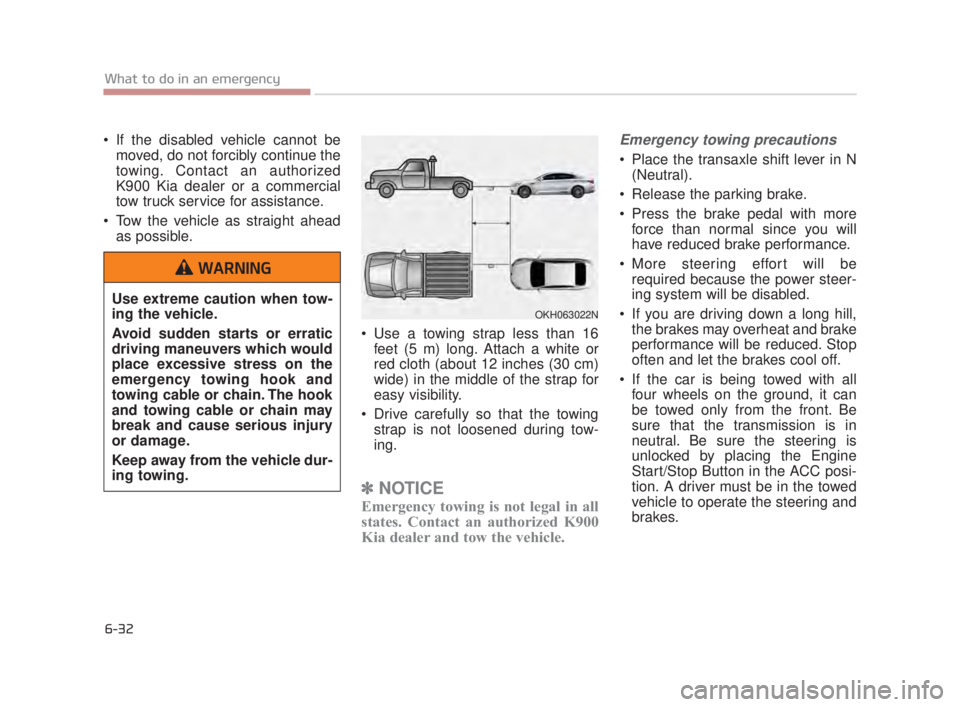
6-32
What to do in an emergency
If the disabled vehicle cannot bemoved, do not forcibly continue the
towing. Contact an authorized
K900 Kia dealer or a commercial
tow truck service for assistance.
Tow the vehicle as straight ahead as possible.
Use a towing strap less than 16feet (5 m) long. Attach a white or
red cloth (about 12 inches (30 cm)
wide) in the middle of the strap for
easy visibility.
Drive carefully so that the towing strap is not loosened during tow-
ing.
✽ NOTICE
Emergency towing is not legal in all
states. Contact an authorized K900
Kia dealer and tow the vehicle.
Emergency towing precautions
Place the transaxle shift lever in N
(Neutral).
Release the parking brake.
Press the brake pedal with more force than normal since you will
have reduced brake performance.
More steering effort will be required because the power steer-
ing system will be disabled.
If you are driving down a long hill, the brakes may overheat and brake
performance will be reduced. Stop
often and let the brakes cool off.
If the car is being towed with all four wheels on the ground, it can
be towed only from the front. Be
sure that the transmission is in
neutral. Be sure the steering is
unlocked by placing the Engine
Start/Stop Button in the ACC posi-
tion. A driver must be in the towed
vehicle to operate the steering and
brakes.
Use extreme caution when tow-
ing the vehicle.
Avoid sudden starts or erratic
driving maneuvers which would
place excessive stress on the
emergency towing hook and
towing cable or chain. The hook
and towing cable or chain may
break and cause serious injury
or damage.
Keep away from the vehicle dur-
ing towing.
WARNING
OKH063022N
KH USA 6:2018 4/12/2017 10:22 AM Page 32
Page 409 of 544
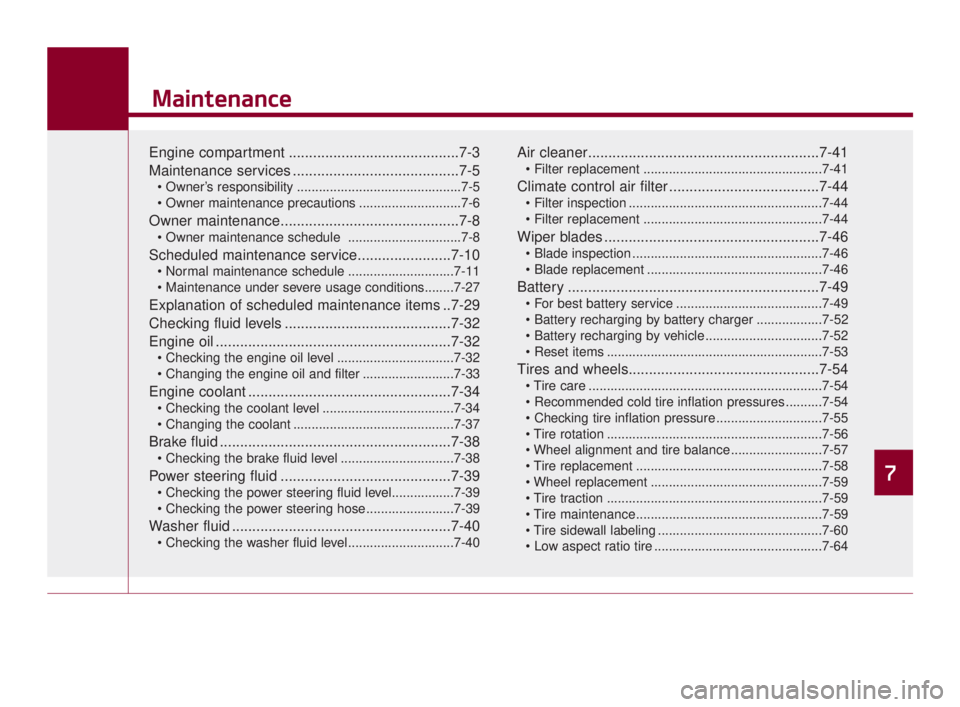
7
Maintenance
Engine compartment ..........................................7-3
Maintenance services .........................................7-5
.............................................7-5
............................7-6
Owner maintenance............................................7-8
...............................7-8
Scheduled maintenance service.......................7-10
.............................7-11
Explanation of scheduled maintenance items ..7-29
Checking fluid levels .........................................7-32
Engine oil ..........................................................7-32
................................7-32
.........................7-33
Engine coolant ..................................................7-34
....................................7-34
............................................7-37
Brake fluid .........................................................7-38
...............................7-38
Power steering fluid ..........................................7-39
Washer fluid ......................................................7-40
.............................7-40
Air cleaner.........................................................7-41
.................................................7-41
Climate control air filter .....................................7-44
.....................................................7-44
.................................................7-44
Wiper blades .....................................................7-46
....................................................7-46
................................................7-46
Battery ..............................................................7-49
........................................7-49
..................7-52
................................7-52
...........................................................7-53
Tires and wheels...............................................7-54
................................................................7-54
..........7-54
.............................7-55
...........................................................7-56
.........................7-57
...................................................7-58
...............................................7-59
...........................................................7-59
.............................................7-60
..............................................7-64
7
KH USA 7:2018 4/14/2017 6:36 PM Page 1
Page 413 of 544
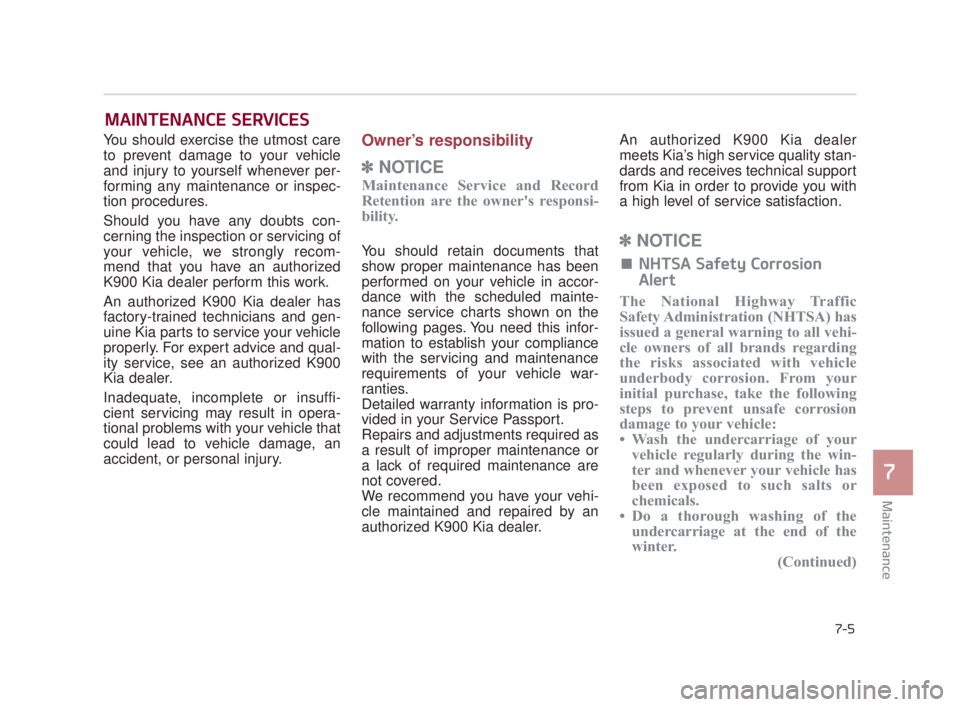
Maintenance
7
7-5
MAINTENANCE SERVICES
You should exercise the utmost care
to prevent damage to your vehicle
and injury to yourself whenever per-
forming any maintenance or inspec-
tion procedures.
Should you have any doubts con-
cerning the inspection or servicing of
your vehicle, we strongly recom-
mend that you have an authorized
K900 Kia dealer perform this work.
An authorized K900 Kia dealer has
factory-trained technicians and gen-
uine Kia parts to service your vehicle
properly. For expert advice and qual-
ity service, see an authorized K900
Kia dealer.
Inadequate, incomplete or insuffi-
cient servicing may result in opera-
tional problems with your vehicle that
could lead to vehicle damage, an
accident, or personal injury. Owner’s responsibility
✽NOTICE
Maintenance Service and Record
Retention are the owner's responsi-
bility.
You should retain documents that
show proper maintenance has been
performed on your vehicle in accor-
dance with the scheduled mainte-
nance service charts shown on the
following pages. You need this infor-
mation to establish your compliance
with the servicing and maintenance
requirements of your vehicle war-
ranties.
Detailed warranty information is pro-
vided in your Service Passport.
Repairs and adjustments required as
a result of improper maintenance or
a lack of required maintenance are
not covered.
We recommend you have your vehi-
cle maintained and repaired by an
authorized K900 Kia dealer. An authorized K900 Kia dealer
meets Kia’s high service quality stan-
dards and receives technical support
from Kia in order to provide you with
a high level of service satisfaction.✽
NOTICE
■ NHTSA Safety Corrosion
Alert
The National Highway Traffic
Safety Administration (NHTSA) has
issued a general warning to all vehi-
cle owners of all brands regarding
the risks associated with vehicle
underbody corrosion. From your
initial purchase, take the following
steps to prevent unsafe corrosion
damage to your vehicle:
• Wash the undercarriage of yourvehicle regularly during the win-
ter and whenever your vehicle has
been exposed to such salts or
chemicals.
• Do a thorough washing of the undercarriage at the end of the
winter. (Continued)
KH USA 7:2018 4/14/2017 6:37 PM Page 5
Page 414 of 544
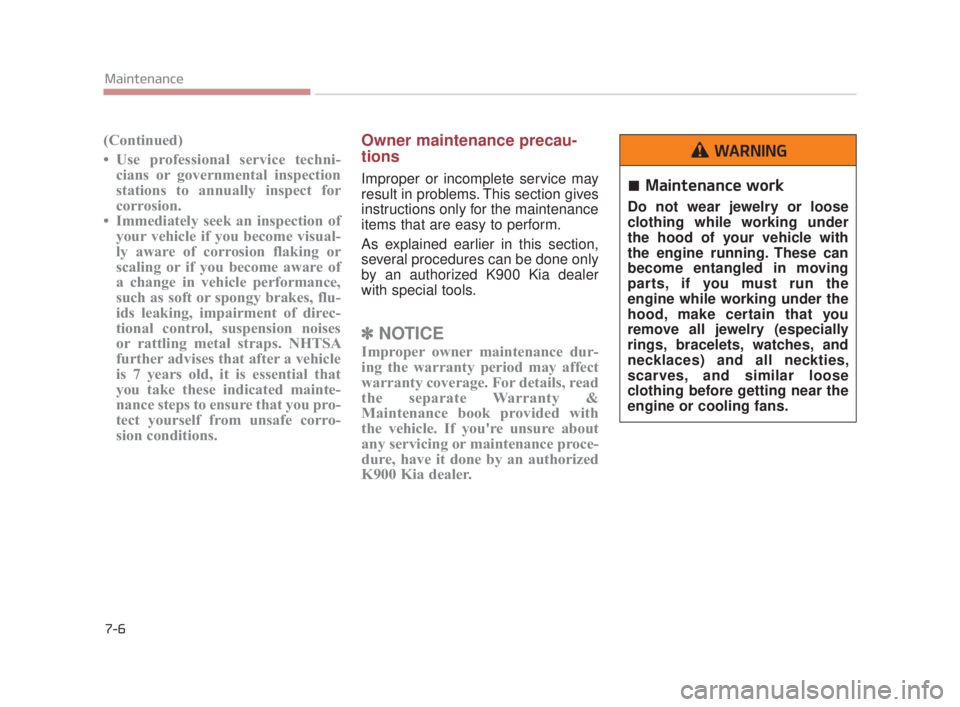
7-6
Maintenance
(Continued)
• Use professional service techni-cians or governmental inspection
stations to annually inspect for
corrosion.
• Immediately seek an inspection of your vehicle if you become visual-
ly aware of corrosion flaking or
scaling or if you become aware of
a change in vehicle performance,
such as soft or spongy brakes, flu-
ids leaking, impairment of direc-
tional control, suspension noises
or rattling metal straps. NHTSA
further advises that after a vehicle
is 7 years old, it is essential that
you take these indicated mainte-
nance steps to ensure that you pro-
tect yourself from unsafe corro-
sion conditions.Owner maintenance precau-
tions
Improper or incomplete service may
result in problems. This section gives
instructions only for the maintenance
items that are easy to perform.
As explained earlier in this section,
several procedures can be done only
by an authorized K900 Kia dealer
with special tools.
✽ NOTICE
Improper owner maintenance dur-
ing the warranty period may affect
warranty coverage. For details, read
the separate Warranty &
Maintenance book provided with
the vehicle. If you're unsure about
any servicing or maintenance proce-
dure, have it done by an authorized
K900 Kia dealer.
Maintenance work
Do not wear jewelry or loose
clothing while working under
the hood of your vehicle with
the engine running. These can
become entangled in moving
parts, if you must run the
engine while working under the
hood, make certain that you
remove all jewelry (especially
rings, bracelets, watches, and
necklaces) and all neckties,
scarves, and similar loose
clothing before getting near the
engine or cooling fans.
WARNING
KH USA 7:2018 4/14/2017 6:37 PM Page 6
Page 418 of 544

7-10
Maintenance
SCHEDULED MAINTENANCE SERVICE
Follow Normal Maintenance Schedule
if the vehicle is usually operated where
none of the following conditions apply.
If any of the following conditions apply,
follow Maintenance Under Severe
Usage Conditions.
Repeated driving short distance ofless than 5 miles (8 km) in normal
temperature or less than 10 miles
(16 km)in freezing temperature
Extensive engine idling or low speed driving for long distances
Driving on rough, dusty, muddy, unpaved, graveled or salt-spread
roads
Driving in areas using salt or other corrosive materials or in very cold
weather
Driving in heavy dust condition
Driving in heavy traffic area
Driving on uphill, downhill, or mountain road repeatedly
Towing a trailer or using a camper, or roof rack
Driving as a patrol car, taxi, other commercial use of vehicle towing
Driving over 106 mile/h(170 km/h) Frequently driving in stop-and-go
condition
If your vehicle is operated under theabove conditions, you should inspect,replace or refill more frequently thanthe following Normal MaintenanceSchedule. After 120 months or150,000 miles (240,000 km) continueto follow the prescribed maintenanceintervals.
KH USA 7:2018 4/14/2017 6:37 PM Page 10